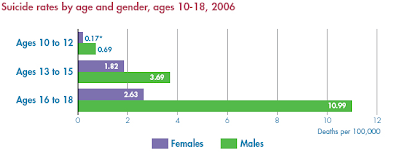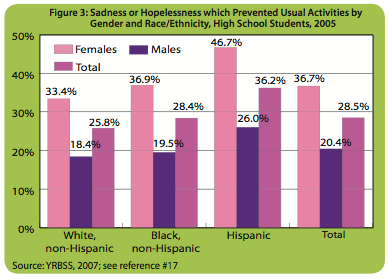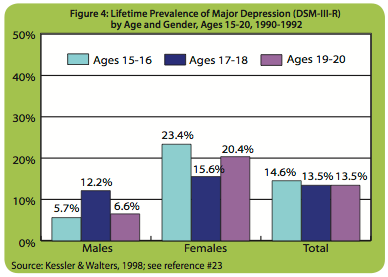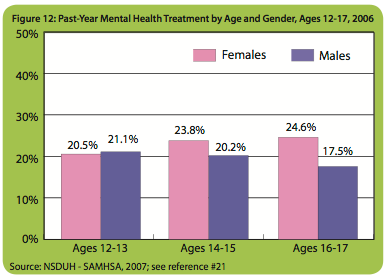This article was last updated on April 16, 2022
Canada: ![]() Oye! Times readers Get FREE $30 to spend on Amazon, Walmart…
Oye! Times readers Get FREE $30 to spend on Amazon, Walmart…
USA: ![]() Oye! Times readers Get FREE $30 to spend on Amazon, Walmart…
Oye! Times readers Get FREE $30 to spend on Amazon, Walmart…
With the meeting of young Americans, mental illness and gun violence once again on the front pages of the world's newspapers, I thought that I'd take a brief look at mental illness among America's youth.
According to the American Psychological Association, up to half of U.S. children and adolescents meet the diagnostic criteria for at least one mental disorder by the time they reach the age of 18. Many of these young Americans begin to exhibit signs of mental disorders at a very young age; the average age of onset for anxiety disorders is 6 years of age, for behavioural disorders the average onset age is 11, for mood disorders the average onset age is 13 and for substance abuse disorders the average onset age is 15.
Here is a bar graph showing the percentage of young Americans who meet the criteria for a mental disorder diagnosis:
Here is another bar graph showing the changes in the number of young Americans with mental health issues over the 1989 – 1999 period:
Let’s look at more detailed information about some key disorders.
The American Academy of Child and Adolescent Psychiatry states that, at any given point in time, one in ten children and adolescents are affected by serious emotional disturbances that can lead to full-blown depression. Between 20 and 30 percent of adolescents have one major depressive episode before they reach adulthood. These episodes often lead to thoughts of suicide or actual suicide attempts. As shown on this graph, the incidence of suicides rises with age with suicide death rates for males aged 16 to 18 being by far the most prevalent:
A total of between 500,000 and one million Americans between the ages of 15 and 24 attempt suicide each year.
Here is a graph showing the percentage of American high school students that have depressive symptoms that impact their participation in their normal activities:
Depression is more than twice as prevalent in females aged 15 to 20 than it is in males of the same age group as shown here:
Schizophrenia affects about one percent of the population or roughly 2.4 million Americans with psychotic symptoms appearing in males during their late teens and early twenties and in females from their mid-twenties to early thirties. It can be difficult to diagnose schizophrenia in teen since the initial symptoms of the illness are common among many teens (i.e. sleep problems, dropping grades, changing friendships etcetera). While people with schizophrenia are not generally violent, when violence takes place it is often directed at family members and is accompanied by substance abuse.
Borderline personality disorders affect about 1.6 percent of adult Americans in a given year. The symptoms of this disorder include problems regulating emotions and thoughts, impulsive and reckless behaviour and unstable relationships with others. This disorder generally begins during adolescence or early adulthood but has been observed during childhood. Both genetic and environmental factors are involved with the development of the disease. Behaviours exhibited include extreme reactions (i.e. rage, panic, depression), stormy relationships with family, unstable self-image, recurring suicidal behaviours, intense and highly changeable moods accompanied by inappropriately intense anger. As many as 80 percent of people with this disorder have suicidal behaviours and 4 to 9 percent commit suicide.
Adolescent Americans are reluctant to seek the mental health care that they need with 70 percent not receiving the care that they so badly need. It is also interesting to note that the number of parents that report behavioural problems in their children varies greatly by age and income level as shown on this graph:
It is the less affluent young Americans that are not seeking help, largely because their families either don't have the necessary insurance coverage or they simply cannot afford the cost of treatment. Data from the Children's Defense Fund shows that there are 7.6 million children in America with no health insurance or 10 percent of all children in the U.S. More than 1290 uninsured American children are born every day. As an example, 19.2 percent of all children or nearly 1.4 million children living in Texas are uninsured. According to this publication by the National Adolescent Health Information Center, only 39.2 percent of children with significant mental health problems received treatment; other studies show that only about 10 percent of children and adolescents with mental health problems received any type of specialty mental health evaluation or service. Older males, aged 16 and 17, were least likely to receive treatment as shown on this graph:
With the data presented in this posting in mind along with the knowledge that the most recent mass shootings were associated with men in their early twenties (Aurora – James Eagan Holmes age 25, Portland – Jacob Tyler Roberts age 22 and Newtown – Adam Lanza age 20), it is becoming increasingly obvious that America's mental health diagnosis and treatment options for young Americans are sadly ineffective. With many of the serious mental disorders that lead to such tragedies germinating in the minds of these men when they were adolescents, perhaps it’s long past time that this issue received more attention from those who control the health care system.
Click HERE to read more of Glen Asher's columns
You can publish this article on your website as long as you provide a link back to this page.








Be the first to comment